
Challenging Solving Improving
Prism Awards Celebrate Photonics Innovations
Winners of 2011 Prism Awards represented an intriguing mix of European and US-based small companies and established businesses. This year’s winners include a 60-laser system for inspecting train rails at high speed, a dual-laser source for eliminating fluorescence effects in Raman spectroscopy, and a breakthrough in miniaturization that enables speckle reduction in laser-based pico projectors.
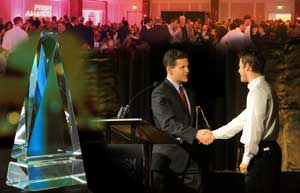
Photos courtesy of Amy Nelson and BayAreaEventPhotography.com
The international competition, co-sponsored by Photonics Media and SPIE, honored the products introduced in the past year that challenge conventional ideas, solve problems and improve life through the generation and harnessing of light. Over the past four years, the awards have grown to become the premier recognition of innovation and new-product development in the photonics industry. (For a complete list of finalists, see the January 2012 issue of Photonics Spectra.)
Life Sciences and Biophotonics
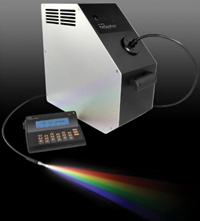 89 North
89 North
Heliophor
The Heliophor is a pumped-phosphor light engine for quantitative fluorescence microscopy, allowing high-speed, live-cell imaging without the need for additional equipment such as shutters and controllers. It provides a new alternative to arc lamps, metal halides and LED light sources, enabling production of a wider range of output wavelengths, all matched to common fluorescent proteins and dyes. The high-speed switching afforded by the pump source allows the light source to serve as its own shutter, while the internal feedback system maintains ultrastable output power.
Other Light Sources
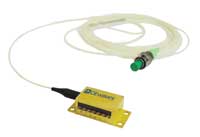 OEwaves
OEwaves
Ultranarrow Linewidth Laser
This narrow linewidth laser source is based on the self-injection locking of a semiconductor laser diode to a proprietary optical whispering gallery mode microresonator. It achieves robust supernarrow instantaneous spectral linewidth of less than 300 Hz in a small 14-pin butterfly package. The wide range of optical transparency of the resonator host material allows narrowing the linewidth of a laser at any wavelength – UV to far-IR – making this capability available in ranges not previously accessible with conventional techniques. These features make the laser suitable for applications in a variety of sensing and communications applications, including harsh environments, as required by many optical-based sensors.
Detectors, Sensing, Imaging and Cameras
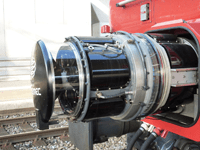 Mermec
Mermec
T-Sight 5000
This system integrates clearance gauge measurement with tunnel wall inspection, sharing the same laser illuminating source to inspect and analyze tunnels and clearance profiles on railways and capturing image data of bridges, underpasses, poles, walls, tree branches and other obstacles that may hinder the safe transport of rail passengers and cargo. The system can be mounted to the front of a high-speed train, replacing visual inspections that must be performed slowly and during off-peak traffic hours. The T-Sight 5000 allows inspections to be performed in real time at speeds greater than 300 km/h.
Scientific Lasers
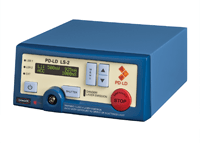 PD-LD Inc.
PD-LD Inc.
LabSource VBG-Stabilized Dual Laser Source
This dual-laser source is used in shifted excitation Raman difference spectroscopy (SERDS), the preferred method for the elimination of fluorescence effects in Raman spectroscopy. It allows taking Raman spectra at two very stable and precisely spaced laser wavelengths and replaces more costly tunable lasers for subtracting the fluorescence contribution from the Raman signal. Volume Bragg grating (VBG)-stabilized laser diodes operate with external feedback from a VBG element. The grating spacing of the VBG determines the wavelength reflected back into the laser cavity and, thus, the emission wavelength of the laser. VBG-stabilized laser diodes have a narrow linewidth and a precisely controlled center wavelength and are considerably smaller, cheaper and simpler to operate than the tunable lasers previously used in SERDS applications.
Defense and Security
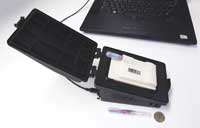 Physical Optics Corp. (POC)
Physical Optics Corp. (POC)
Mobile ELISA-Based Pathogen Detection (MEPAD)
The Mobile ELISA is a biohazard detection system with a highly sensitive portable fluorimeter and automated processing for disposable microfluidic chips. It provides responders and point-of-care specialists with a cost-efficient and automated ELISA-based process for field use and identification of concentrations below 100 ng/ml. The fluorescence detection subsystem is composed of a 635-nm diode laser, an avalanche photodiode that measures fluorescence, and three filtering mirrors.
Industrial Lasers
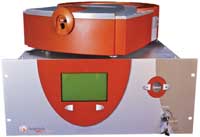 Amplitude Systèmes
Amplitude Systèmes
Satsuma HE
This high-power ultrafast fiber laser combines characteristics that are usually mutually exclusive: a pulse energy greater than 20 µJ, an average power greater than 10 W, and an air-cooled housing that measures less than 13 x 30 in. Applications for such ultrafast lasers are rapidly growing and include eye surgery, medical device manufacturing and semiconductor processing.
Optics and Optical Components
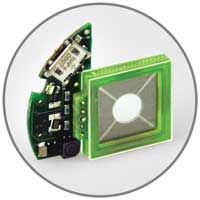 Optotune AG
Optotune AG
Laser Speckle Reducer
Speckle contrast in laser illumination is a major roadblock to the laser’s becoming the “focus free” standard for projection light sources. Although a traditional approach is to use rotating diffusers, which destroy the temporal and spatial coherence of the laser and smear the speckle pattern, the Laser Speckle Reducer uses electroactive polymers (EAPs, also known as artificial muscles) to oscillate a diffuser, enabling speckle reduction in laser-based pico projectors. The diffuser is mounted on an elastic membrane and moved back and forth using EAPs, resulting in a planar circular oscillation of the diffuser with lateral deflections of 100 to 500 µm at frequencies of several hundred hertz.
Green Photonics/Sustainable Energy
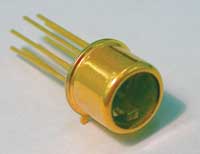 nanoplus
nanoplus
DFB Laser at 3 µm
These DFB (distributed feedback) laser diodes perform at the previously unattainable wavelength range between 2.9 and 3.4 µm for tunable diode laser spectroscopy applications, an important technique for gas detection. Reaching that spectral range was made possible, in part, by the recent commercial availability of application-grade laser sources in that region for sensor applications.
Test, Measurement, Metrology
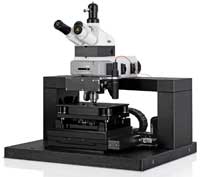 WITec GmbH
WITec GmbH
True Surface Microscopy
True Surface Microscopy is an imaging technique that follows the surface topography with high precision so that even rough or inclined samples always stay in focus while performing confocal (Raman) imaging. With this new imaging mode, samples that previously required extensive preparation to obtain a certain surface flatness now can be effortlessly and automatically characterized as they are.
Thanks to the award presenters at Photonics West: Timothy Day, Daylight Solutions; Mary Lou Jepsen, Pixel Qi; Wellington Chadehumbe, Triumph Venture Capital; Michael Lebby, Translucent Inc.; Laura Smoliar, Peppertree Engineering; Robert Huang, Wavelength Technology Pte Ltd.; Michael J. Cumbo, Idex Optics & Photonics; Rob Randelman, Halma; and Larry Marshall, Southern Cross Venture Partners.
/Buyers_Guide/89_North/c18709